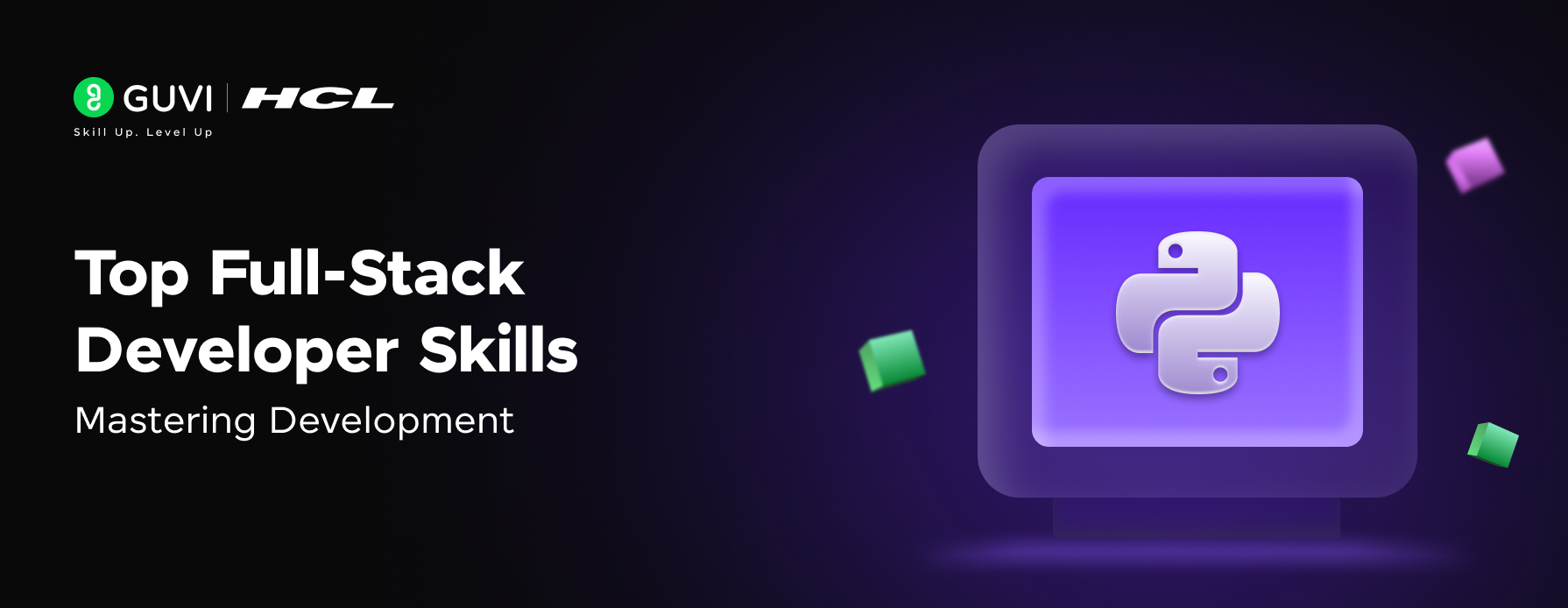
Top Full-Stack Developer Skills: Mastering Development
Mar 25, 2025 6 Min Read 5306 Views
(Last Updated)
In today’s fast-paced world, finding the top skills to master full-stack development can be both time-consuming and overwhelming. Are you also feeling lost in your search for the essential developer skills, just like I was a year ago? Well, you’re in the right place.
Whether you’re a beginner or an experienced developer eager to learn the latest Full-Stack developer skills, this blog is perfect for you. Stick with me till the end!
In this blog, we’ll explore the top skills every full-stack developer should know. Beyond technical abilities, we’ll also discuss the mindset of a developer and the essential soft skills needed for success.
Table of contents
- What is Full-Stack Development?
- What are The Responsibilities of a Full Stack Developer?
- Top Full-Stack Developer Skills
- Programming Concepts
- Design Skills
- Front-End Skills
- Back-End Skills
- Mobile App Development
- Soft Skills
- Problem-Solving
- Communication
- Time Management
- Conclusion
- FAQs
- What are the essential skills required to become a full-stack developer?
- Is it necessary to know cloud platforms for Full-Stack Development?
- How important is learning version control for a full-stack developer?
- What role does DevOps play in full-stack development?
- How can full-stack developers stay updated with the latest technologies?
What is Full-Stack Development?
Full-stack development refers to the practice of working with both the front-end and back-end of web applications. It involves a broad range of technologies, from user interface design to server-side programming. Mastery of these skills allows developers to build, manage, and optimize complete web applications.
What are The Responsibilities of a Full Stack Developer?
A full-stack developer is skilled in multiple layers of development, ensuring smooth interaction between the front-end and back-end systems. The responsibilities include the following,
- They are responsible for creating the user interaction side of the application, ensuring it is responsive, intuitive, and visually appealing.
- They handle server-side programming, database management, and the logic that powers the application, ensuring it functions efficiently and securely.
- They work to seamlessly integrate the front-end with the back-end, ensuring smooth communication between the user interface and a server.
Let’s deep dive into the necessary skills that a full-stack developer should possess.
Top Full-Stack Developer Skills
1. Programming Concepts
Programming concepts refer to fundamental principles like variables, loops, and functions that form the foundation of writing software. These concepts help developers structure code effectively and solve problems efficiently. A solid understanding of fundamental computer science concepts is crucial for solving complex problems efficiently.
- Data Structures & Algorithms
Data Structures and Algorithms (DSA) are foundational concepts in computer science that help in efficiently organizing and processing data. For a full-stack developer, DSA is essential for optimizing both frontend and backend performance, ensuring faster response times and resource management.
- Common Data Structures: Arrays, linked lists, stacks, queues, trees, and graphs.
- Algorithm Design: Sorting, searching, and graph algorithms.
- Big O Notation: Analyzing and optimizing algorithm efficiency.
- Object Oriented Programming
For a Full-Stack Developer (FSD), Object Oriented Programming simplifies managing complex systems by breaking down tasks into smaller, manageable components. It helps in writing cleaner, maintainable code for both frontend and backend, ensuring scalability and flexibility.
- Classes and Objects: Grasping encapsulation and abstraction for better data management.
- Inheritance and Polymorphism: Enabling code reusability and extensibility.
- Design Patterns: Knowledge of common patterns such as Singleton, Factory, and Observer for efficient problem-solving.
2. Design Skills
Designing skills are essential for creating visually appealing and user-friendly interfaces that enhance the overall user experience. Full-stack developers should possess these skills to ensure both the frontend and backend are integrated seamlessly, leading to aesthetically pleasing and functional applications.
- User Interface (UI)
User Interface (UI) design focuses on creating visually appealing and intuitive interfaces that enhance user interaction with applications. Full-stack developers should possess UI design skills to bridge the gap between the backend and frontend, ensuring a seamless user experience. A strong understanding of UI principles allows full-stack developers to build aesthetically pleasing, easy-to-navigate interfaces. This skill helps in delivering functional and user-friendly applications, boosting customer satisfaction and engagement.
- User Experience (UX)
User Experience (UX) design focuses on optimizing the overall experience users have when interacting with an application, ensuring it is intuitive, efficient, and enjoyable. Full-stack developers should have UX skills to create applications that meet user needs while providing smooth and engaging experiences. Understanding UX principles helps full-stack developers to design products that are easy to use, reducing friction and improving user satisfaction. This skill is essential for building applications that not only function well but also delight users, fostering loyalty and positive feedback.
3. Front-End Skills
Front end guides the user in navigating the website and allows them to interact with the application. As a beginner in front end development, you should focus on the below programming languages that are dedicated for web development.
HTML
HTML (HyperText Markup Language) is a markup language used to define the structure and content of a website. It provides the foundation for web pages by using a series of elements, such as headings, paragraphs, links, images, and lists, to organize and display information.
- Semantic HTML: Using meaningful HTML tags to improve accessibility, SEO, and code readability.
- Forms and Input Elements: Implementing well-structured forms with proper input types for better user experience and validation.
- HTML5 Features: Leveraging modern HTML5 elements like <video>, <audio>, and <canvas> for richer multimedia and interactive content.
CSS
CSS (Cascading Style Sheets) is a language used to define the visual appearance of a webpage, including layout, colors, fonts, and spacing. It separates content from design, allowing for a cleaner and more maintainable code structure
- Box Model: Understanding the CSS box model (margin, border, padding, and content) to control element layout and spacing.
- Flexbox and Grid: Using Flexbox and CSS Grid for creating responsive, flexible, and well-structured layouts.
- CSS Transitions and Animations: Enhancing user experience with smooth transitions and animations to improve interaction and visual appeal.
JavaScript
JavaScript is a versatile, high-level programming language primarily used for creating interactive and dynamic web content. It plays a key role in web development (frontend and backend), mobile app development, game development, and server-side applications.
JavaScript features include dynamic typing, event-driven programming, asynchronous execution, and support for object-oriented, functional, and imperative programming styles.
Responsive Design
Responsive design ensures web pages adapt seamlessly to different screen sizes and devices, providing an optimal user experience. Key aspects include:
- Mobile-First Approach: Designing for mobile devices first, then scaling for larger screens.
- CSS Media Queries: Applying styles based on device characteristics.
- Responsive Frameworks: Familiarity with frameworks like Bootstrap or Tailwind CSS for efficient design implementation.
Frameworks
Front-end frameworks are the collection of pre-written codes that help the developers to build the user interface in ease. This includes Html, CSS and javascript components.
Here are the top front-end frameworks you can start with,
- React Js: Flexible JavaScript library for building user interfaces, developed by Facebook.
- Angular Js: Platform and framework for building client-side applications, developed by Google.
- Vue Js: Progressive JavaScript framework used for building UIs and single-page applications.
- jQuery: Fast, small, and feature-rich JavaScript library.
- Next Js: The library for web and native user interfaces.
- Svelte: Radical new approach to building user interfaces.
- Backbone Js: Offers minimal structure and leaves many choices to the developer, making it more of a library than a full-fledged framework.
4. Back-End Skills
Server Side Languages
Server-side languages are used to handle backend logic, enabling data processing and interactions with databases. Full-stack developers should be proficient in at least one server-side programming language.Popular choices include:
- Node.js: JavaScript runtime for server-side development, allowing full-stack JavaScript.
- Python: Simple and powerful, widely used in web development, data science, and machine learning.
- Ruby: Often paired with Ruby on Rails for rapid web application development.
- Java: Known for robustness, scalability, and enterprise-level applications with frameworks like Spring.
- PHP: Widely used for dynamic websites and CMS like WordPress.
Databases
Database is a structured collection of data that is stored electronically. It can store data in the form of numbers, texts, images, videos and other types of data. Understanding how to store, retrieve, and manage data is crucial for any full-stack developer.
- SQL Databases: Relational databases like MySQL, PostgreSQL, or SQL Server, storing data in structured tables with predefined schemas.
- NoSQL Databases: Non-relational databases like MongoDB (document-oriented) or Redis (key-value store), offering flexibility for unstructured or semi-structured data.
Difference: SQL databases use structured tables and support complex queries, while NoSQL databases are more flexible, handling unstructured data with dynamic schemas.
APIs
APIs (Application Programming Interfaces) are the glue that connects different parts of an application or even different applications altogether.
- REST Principles: Understanding RESTful architecture and how to design clean, efficient APIs.
- API Documentation: Using tools like Swagger or Postman to create and maintain API documentation.
- GraphQL: Knowledge of this query language for APIs as an alternative to REST.
Frameworks
Backend frameworks are collections of tools that help developers efficiently build and manage server-side web applications. They provide pre-built structures, libraries, and functions for handling tasks like routing, database interaction, and authentication.
The common backend frameworks are,
- Express Js: Node Js framework for building web applications and APIs that can be used to build single-page, multi-page, and hybrid applications.
- Django: Python framework that’s flexible and can quickly scale to meet new demands.
- SpringBoot: An open-source framework for the Java platform that can be used to develop web applications and websites.
Server Management
Server management refers to the process of configuring, maintaining, and securing servers to ensure they run smoothly and efficiently. While not always required, having knowledge of server management can be a significant advantage for developers.
- Basic Linux Commands: Ability to navigate and manage servers using the command line.
- Web Servers: Configuring and maintaining servers like Apache or Nginx.
- Security Best Practices: Implementing measures to protect against common vulnerabilities.
DevOps
DevOps is a set of practices that combines software development and IT operations to shorten the development lifecycle and improve the quality of software. It emphasizes automation, continuous integration, continuous delivery, and collaboration between development and operations teams.
Git
Git is a distributed version control system that helps developers track changes in code and collaborate on projects. It allows multiple developers to work on the same codebase, maintaining a history of changes and enabling easy branching and merging. The top two common Git platforms are GitHub and GitLab.
GitHub is a widely-used platform for hosting Git repositories, offering features like pull requests, issue tracking, and collaboration tools for open-source and private projects. GitLab provides similar functionality with a focus on DevOps integration, offering continuous integration, deployment, and project management tools all in one platform.
- Git: Proficiency in Git commands, branching strategies, and workflows.
- GitHub/GitLab: Familiarity with popular platforms for hosting and collaborating on code repositories.
CI/CD
CI/CD (Continuous Integration/Continuous Deployment) is a set of practices designed to automate the software development, testing, and deployment process. Continuous Integration (CI) ensures that developers frequently integrate code into a shared repository, with automated tests running to catch errors early and prevent breaking changes. Continuous Deployment (CD) automates the delivery of code changes to production, enabling faster and more reliable updates.
- CI Tools: Experience with platforms like Jenkins, Travis CI, or CircleCI.
- Automated Testing: Implementing unit tests, integration tests, and end-to-end tests.
Cloud Platforms
Cloud platforms provide on-demand access to computing resources, such as storage, processing power, and databases, over the internet. Popular platforms like AWS, Azure, and Google Cloud enable scalable, cost-efficient infrastructure for developing, deploying, and managing applications.
- AWS (Amazon Web Services): The leading cloud platform, offering a vast array of services.
- Microsoft Azure: A strong contender, especially in enterprise environments.
- Google Cloud Platform: Known for its strengths in data analytics and machine learning
Containerization
Containerization is a lightweight form of virtualization that allows applications to run consistently across different environments by packaging them with their dependencies. Tools like Docker enable developers to create, deploy, and manage containers for more efficient, scalable, and isolated application deployment.
- Docker: The most popular containerization platform.
- Kubernetes: For orchestrating and managing containerized applications at scale.
5. Mobile App Development
Mobile app development involves creating software applications for mobile devices, tailored to either iOS, Android, or cross-platform environments. Here’s a table comparing the skills required for iOS, Android, and Hybrid app development:
| Skill | IOS App Dev | Android App Dev | Hybrid App Dev |
| Primary Language | Swift, Objective-C | Kotlin, Java | JavaScript, HTML, CSS |
| Development Environment | Xcode (macOS) | Android Studio (Windows/macOS) | Frameworks like React Native, Ionic, Flutter |
| UI Design | UIKit, SwiftUI | XML, Jetpack Compose | Web-based UI components |
| App Store | Apple App Store | Google Play Store | Multiple stores (Google Play, Apple Store) |
| Development Speed | Slower due to strict guidelines | Faster development cycle, more flexibility | Faster development with a single codebase |
6. Soft Skills
While technical skills are crucial, soft skills often differentiate good developers from great ones.
7. Problem-Solving
The ability to break down complex problems into manageable parts is at the heart of development.
- Analytical Thinking: Approaching problems systematically and logically.
- Creativity: Finding innovative solutions to unique challenges.
- Debugging: Efficiently identifying and fixing issues in code.
8. Communication
Clear communication is essential when working in teams and with non-technical stakeholders.
- Technical Writing: Documenting code and writing clear specifications.
- Presentation Skills: Explaining technical concepts to diverse audiences.
- Active Listening: Understanding requirements and feedback effectively.
9. Time Management
Balancing multiple tasks and meeting deadlines is crucial in fast-paced development environments.
- Prioritization: Focusing on high-impact tasks and managing workload effectively.
- Estimation: Accurately estimating the time required for various development tasks.
- Work-Life Balance: Maintaining productivity without burning out.
Learn all these skills in a well-structured certification course on GUVI’s Full Stack Development course by reputed IITM. Through this course, you will receive mentorships, mock interviews and live online sessions.
Conclusion
In conclusion, by following these steps, you can gain a comprehensive understanding of the entire process, from designing to deploying an application. With consistent practice and dedication, you’ll be well on your way to building your own software and mastering the skills needed for future projects.
FAQs
Full-stack developers need proficiency in both front-end (HTML, CSS, JavaScript) and back-end technologies (Node.js, Python, Ruby). They should also be familiar with databases (SQL, NoSQL), version control (Git), and web servers.
While not strictly required, knowledge of cloud platforms like AWS, Google Cloud, or Azure can be a big advantage, as they allow Full-Stack Developers to deploy, scale, and manage applications in a cloud environment.
Version control systems like Git are essential for tracking changes in code, collaborating with other developers, and managing different versions of a project. Mastery of version control is critical for maintaining code quality and ensuring seamless teamwork.
DevOps involves practices like continuous integration and deployment (CI/CD), which are key for automating and streamlining the development process. Full-stack developers benefit from understanding DevOps to manage end-to-end project lifecycles efficiently.
Full-stack development is a rapidly evolving field. Developers should continuously learn through online courses, coding challenges, contributing to open-source projects, and following industry trends to stay competitive and enhance their skill set.


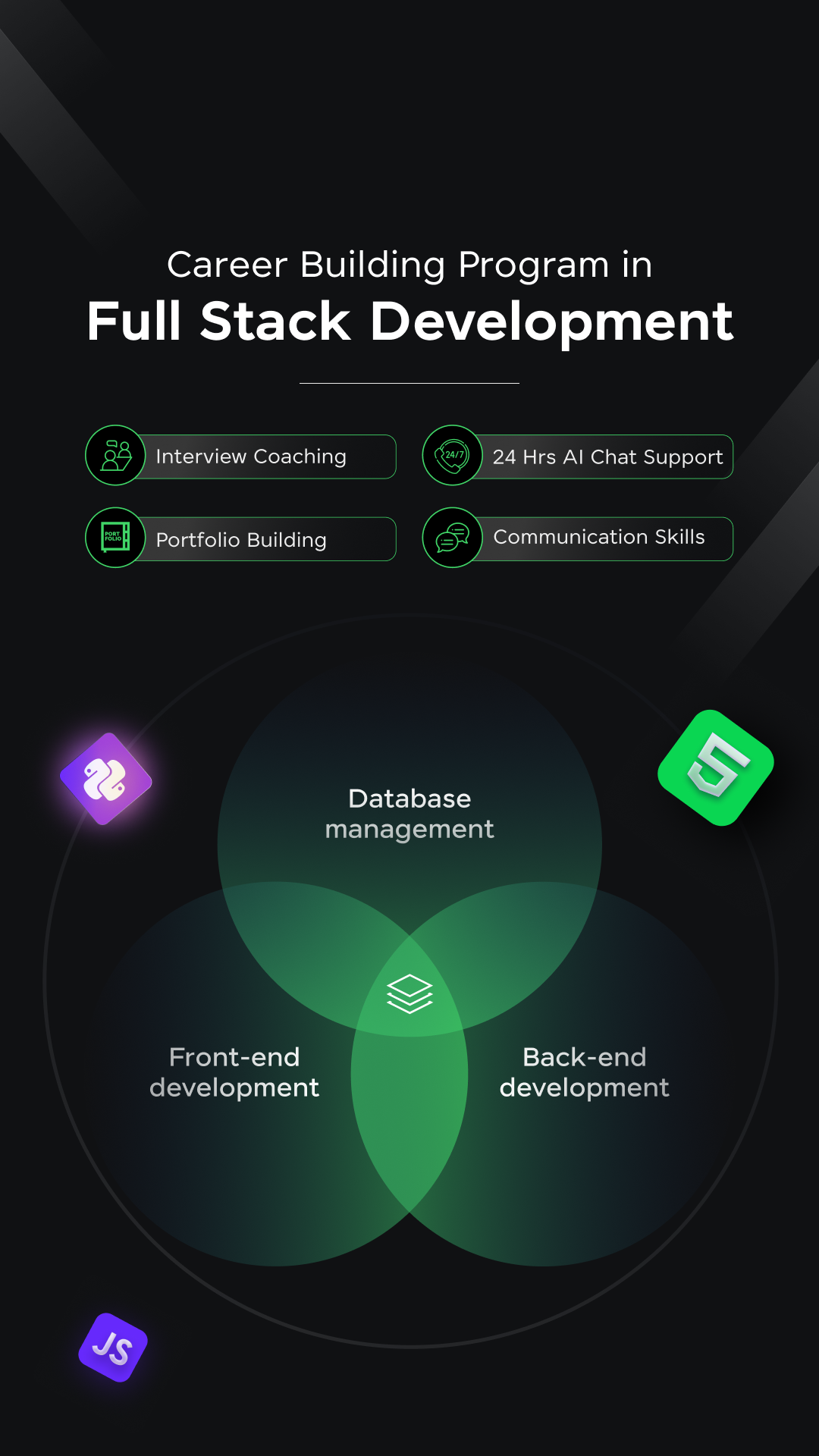



















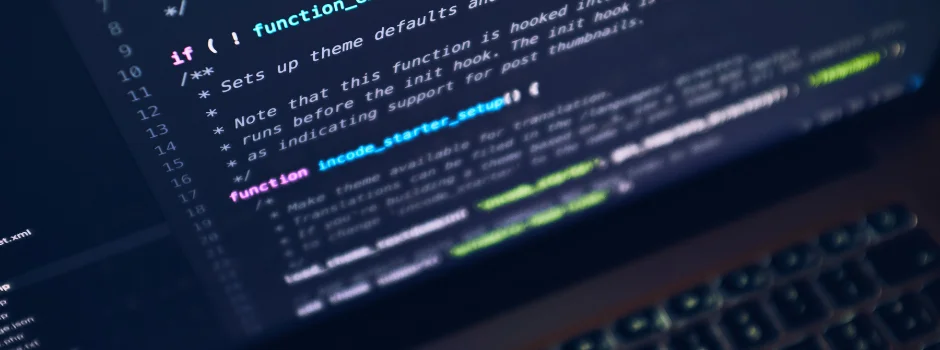
![9 Compelling Project Ideas for Frontend Development [With Source Code] 12 Feature image - Comprehensive List of Project Ideas for Frontend Development](https://www.guvi.in/blog/wp-content/uploads/2024/02/9-Compelling-Project-Ideas-for-Frontend-Development-With-Source-Code.webp)
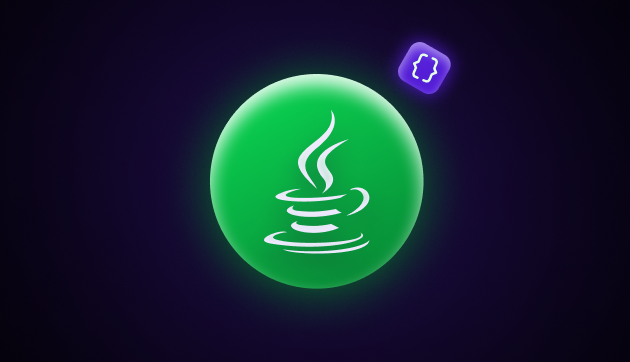
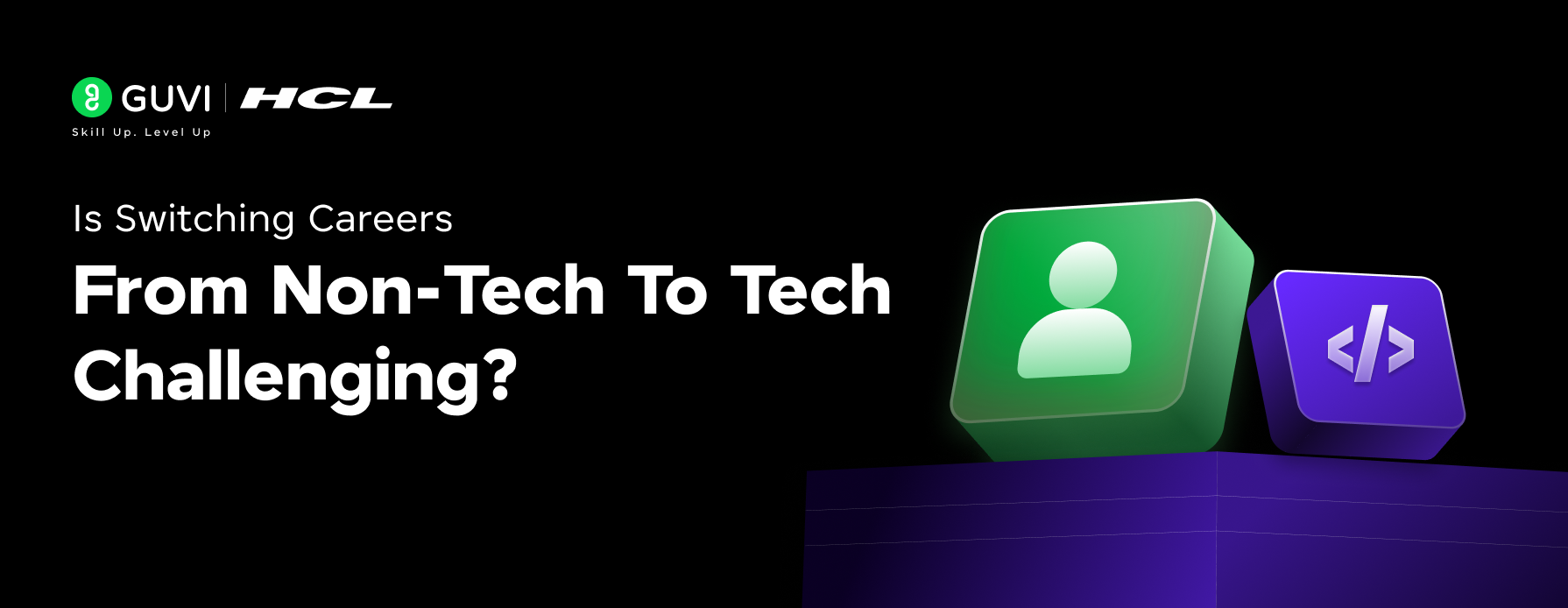
![Top Full Stack Web Developer Coding Projects in 2025 [With Source Code] 14 full stack web developer coding projects](https://www.guvi.in/blog/wp-content/uploads/2021/10/Top-Full-Stack-Web-Developer-Coding-Projects-With-Source-Code.png)
![Top 20+ React Interview Questions and Answers [2025] 15 Top 20 React Interview Questions and Answers](https://www.guvi.in/blog/wp-content/uploads/2022/01/Top-20-React-Interview-Questions-and-Answers.png)
![What is ReactJS? A Beginner's Guide [2025] 16 what is reactjs](https://www.guvi.in/blog/wp-content/uploads/2025/04/What-is-ReactJS_-A-Beginners-Guide.png)
![Top 10 React Native Project Ideas [With Source Code] 17 React Native Project Ideas](https://www.guvi.in/blog/wp-content/uploads/2024/10/React_Project_Ideas.png)


Did you enjoy this article?